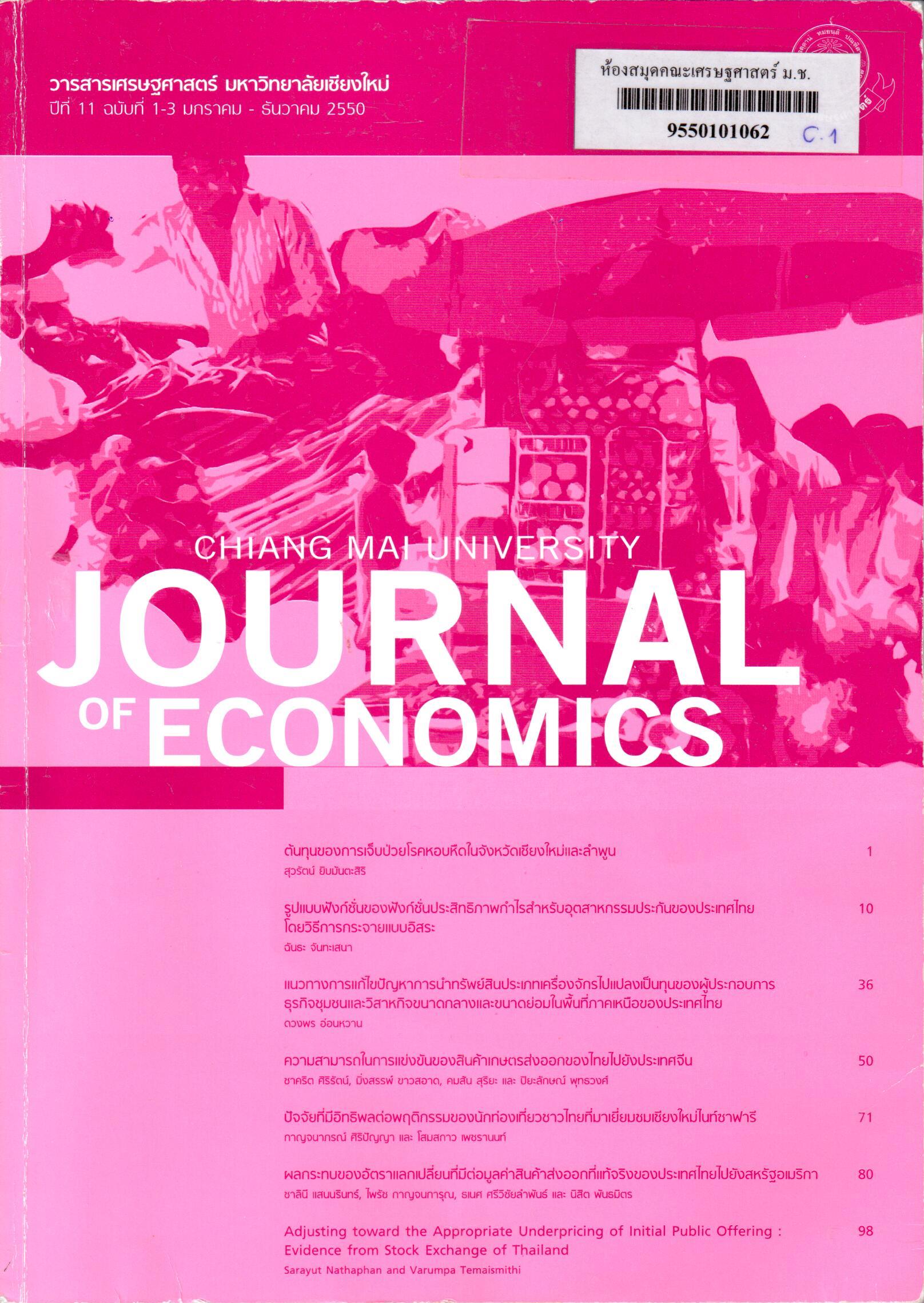ผลกระทบของอัตราแลกเปลี่ยนที่มีต่อมูลค่าสินค้าส่งออกที่แท้จริงของประเทศไทยไปยังสหรัฐอเมริกา
Abstract
บทคัดย่อ
การศึกษานี้มีวัตถุประสงค์เพื่อศึกษาถึง ความผันผวนของอัตราแลกเปลี่ยน ดัชนีราคาสินค้าส่งออกเปรียบเทียบ และผลผลิตมวลรวมภายในประเทศของประเทศสหรัฐอเมริกาว่ามีผลกระทบต่อการส่งออกของไทยใน 3 กรณีด้วยกันคือ กรณีแรกมูลค่าสินค้าส่งออกรวม กรณีที่สองมูลค่าสินค้าส่งออกอุตสาหกรรม และกรณีสุดท้ายคือมูลค่าสินค้าส่งออกนอกภาคอุตสาหกรรม ในการศึกษาโดยใช้แบบจำลอง GARCH (Generalized Autoregressive Conditional Heteroskedasticity) และได้ประยุกต์ใช้เทคนิคโคอินทีเกรชันและแบบจำลองเอเรอร์คอร์เรคชัน (Cointegration and Error Collection Model) เพื่อวิเคราะห์หาความสัมพันธ์เชิงดุลยภาพระยะยาวและการปรับตัวในระยะสั้นของแบบจำลอง นอกจากนั้นได้ศึกษาการเปลี่ยนแปลงด้านโครงสร้างและการเปลี่ยนแปลงทางด้านแนวโน้มโดยใช้ตัวแปรหุ่น (dummy) เข้าไปในแบบจำลองด้วยเนื่องจากช่วงเวลาที่ได้ทำการศึกษานั้นประเทศไทยได้ใช้ระบบอัตราแลกเปลี่ยน 2 ระบบด้วยกันคือ ระบบอัตราแลกเปลี่ยนแบบตะกร้าเงินและระบบอัตราแลกเปลี่ยนแบบลอยตัวภายใต้การจัดการ กล่าวคือ ตั้งแต่ไตรมาสที่ 1 ปี 2534 ถึงไตรมาสที่ 4 ปี 2549 รวมทั้งสิ้น 64 ไตรมาส
เนื่องจากข้อมูลที่ใช้เป็นข้อมูลอนุกรมเวลา ดังนั้นจึงต้องทำการทดสอบคุณสมบัติความนิ่งของข้อมูลสำหรับทุกตัวแปรโดยใช้วิธี Unit Root Test ผลการทดสอบพบว่าตัวแปรทุกตัวมีลักษณะไม่นิ่ง (None-stationary) และมีอันดับความสัมพันธ์ของข้อมูลอันดับที่ 1 หรือ I(1) สำหรับวิธีทดสอบโคอินทิเกรชันของ Engel and Granger ผลการศึกษาพบว่าทุกตัวแปรในแบบจำลองทั้งหมดมีความสัมพันธ์กันเชิงดุลยภาพในระยะยาว
สำหรับการประมาณแบบจำลองเอเรอร์คอร์เรคชัน เพื่ออธิบายกลไกการปรับตัวในระยะสั้น พบว่ามีการเปลี่ยนแปลงมูลค่าสินค้าส่งออกของไทยในแต่ละกรณีนั้นขึ้นอยู่กับการเปลี่ยนแปลงของตัวแปรต่างๆคือความผันผวนของอัตราแลกเปลี่ยน ดัชนีราคาสินค้าส่งออกเปรียบเทียบ และผลผลิตมวลรวมภายในประเทศสหรัฐอเมริกาในไตรมาสที่ผ่านมาหลายช่วงแตกต่างกันไปอย่างมีนัยสำคัญทางสถิติ และทิศทางการเปลี่ยนแปลงก็เป็นไปตามสมมติฐานทั้งหมด แต่สำหรับในกรณีมูลค่าสินค้าอุตสาหกรรมส่งออกของไทยนั้น ผลผลิตมวลรวมภายในประเทศสหรัฐอเมริกาไม่มีผลต่อมูลค่าสินค้าอุตสาหกรรมส่งออกของไทย เมื่อพิจารณาด้านการเปลี่ยนแปลงทางด้านโครงสร้างและแนวโน้มพบว่า มูลค่าสินค้าอุตสาหกรรมส่งออก และมูลค่าสินค้าที่ไม่ใช่อุตสาหกรรมส่งออก มีการเปลี่ยนแปลงทั้งทางด้านโครงสร้างและแนวโน้มเมื่อมีการใช้ระบบอัตราแลกเปลี่ยนแบบลอยตัวภายใต้การจัดการ แต่สำหรับกรณีมูลค่าสินค้าส่งออกรวมจะมีการเปลี่ยนแปลงทางด้านโครงสร้างอย่างเดียวกล่าวคือ เมื่อมูลค่าการส่งออกเพิ่มสูงขึ้นมากหลังจากได้เปลี่ยนแปลงระบบอัตราแลกเปลี่ยนดังกล่าว นอกจากนั้นการปรับตัวของมูลค่าสินค้าส่งออกทั้ง 3 กรณี ยังขึ้นอยู่กับความเบี่ยงเบนออกจากดุลยภาพในไตรมาสที่ผ่านมาด้วย โดยพบว่า ค่าความเร็วใน การปรับตัวระยะสั้นเพื่อเข้าสู่ดุลยภาพในระยะยาวของกรณีมูลค่าสินค้าอุตสาหกรรมส่งออกมีค่ามากที่สุด รองลงมาคือมูลค่าสินค้าที่ไม่ใช่อุตสาหกรรมส่งออกและสุดท้ายคือมูลค่าสินค้าส่งออกรวม
Abstract
This study was an attempt to ascertain whether the exchange rate volatility, the relative export price index and the US. Gross Domestic Product (GDP) had impacts on the value of total exports, the value of industry exports and the value of non-industry exports of Thailand. This study employed the Generalized Autoregressive Conditional Heteroskedasticity model (GARCH) to estimate the exchange rate volatility, and the Cointegration and Error Correction Model (ECM) to define the correlation between the long-run equilibrium relationship and the short-run adjustment process in these models. Furthermore, dummy variables were included in the models to consider the structural change and tent. At the time of this study, Thailand used two systems of exchange rate: the basket of currencies exchange rate and the managed float system with covered the first quarter of 1991 to the forth quarter of 2007 including a total 64 observations.
For time series data, it was important to investigate stationary property of all variables using unit roots test. The results revealed that all series were found to be stationary at the first order of integration. The Engle and Granger Cointegration test results substantially supported the long-run equilibrium relationship.
Furthermore, this study applied the Error correction model to combine the short-run effects and the adjustment process of the value of exports through the long-run equilibrium relationship. The results indicated that the change of value exports depended on the change of lagged variables which included the exchange rate volatility, the relation export price index and US’ Gross Domestic Product. All of the variables appeared to have significant effect as expected. However, in the industry exports case, the US’ Gross Domestic Product had no effect in short-run. Historical evidence also revealed that the industry exports and non-industry exports experienced the change in both structure and trend when managed float system was applied, while the total exports dramatically increase with change in structure only. In addition to the economic factors: the values of exports, industry exports and non-industry exports also responded to changes in the disequilibrium error in the previous period. The fastest speed of adjustment occurred in the case of industry exports, non-industry exports and the total exports, respectively.
Downloads
Issue
Section
License
All opinions and contents in the CMJE are the responsibility of the author(s). Chiang Mai University Journal of Economics reserves the copyright for all published materials. Papers may not be reproduced in any form without the written permission from Chiang Mai University Journal of Economics.
ข้อคิดเห็นที่ปรากฏและแสดงในเนื้อหาบทความต่างๆในวารสารเศรษฐศาสตร์มหาวิทยาลัยเชียงใหม่ ถือเป็นความเห็นและความรับผิดชอบโดยตรงของผู้เขียนบทความนั้นๆ มิใช่เป็นความเห็นและความรับผิดชอบใดๆของวารสารเศรษฐศาสตร์ มหาวิทยาลัยเชียงใหม่
บทความ เนื้อหา และข้อมูล ฯลฯ ในวารสารเศรษฐศาสตร์มหาวิทยาลัยเชียงใหม่ ถือเป็นลิขสิทธิ์เฉพาะของคณะเศรษฐศาสตร์มหาวิทยาลัยเชียงใหม่ หากบุคคลหรือหน่วยงานใดต้องการนำทั้งหมดหรือส่วนหนึ่งส่วนใดไปเผยแพร่ต่อหรือเพื่อกระทำการใดๆ จะต้องได้รับอนุญาตเป็นลายลักษณ์อักษร จากวารสารเศรษฐศาสตร์ มหาวิทยาลัยเชียงใหม่






